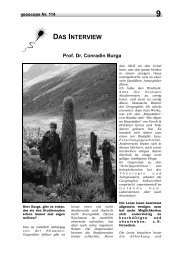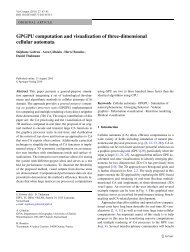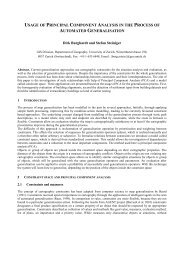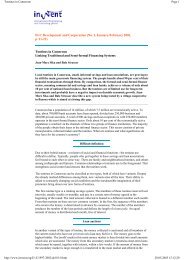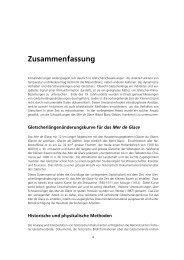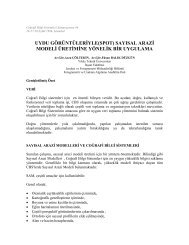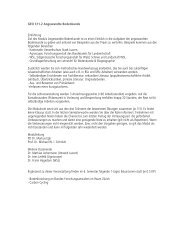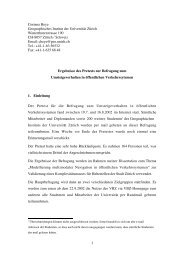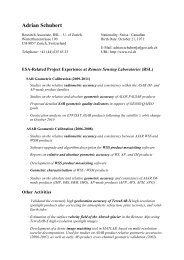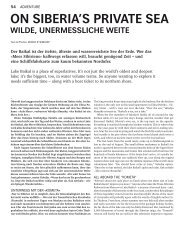KYRGYZSTAN TODAY Policy briefs on - Department of Geography
KYRGYZSTAN TODAY Policy briefs on - Department of Geography
KYRGYZSTAN TODAY Policy briefs on - Department of Geography
Create successful ePaper yourself
Turn your PDF publications into a flip-book with our unique Google optimized e-Paper software.
is the Philippines, <strong>of</strong>ten described as a successful example <strong>of</strong> maximizing the benefits <strong>of</strong><br />
migrati<strong>on</strong>.<br />
In accordance with the selected policy, the government <strong>of</strong> Kyrgyzstan is now working<br />
to legalize labor migrati<strong>on</strong> from the Republic, and is c<strong>on</strong>cluding bilateral agreements<br />
with some countries. An example is the treaty with Korea, c<strong>on</strong>cluded in 2007, which<br />
established a quota <strong>of</strong> 5,000 people. It is difficult to say whether this program will be<br />
successful, since few specialists in Kyrgyzstan now know the Korean language well<br />
enough.<br />
In formulating and discussing the policy <strong>of</strong> exporting a labor force, <strong>on</strong>e should<br />
understand that the success <strong>of</strong> the strategy depends <strong>on</strong> the demands <strong>of</strong> the labor market<br />
in the CIS and other countries chosen by migrants in search <strong>of</strong> employment.<br />
The success <strong>of</strong> this strategy demands certain c<strong>on</strong>diti<strong>on</strong>s: identifying the needs <strong>of</strong><br />
the labor markets <strong>of</strong> recipient countries, predicting changes in these markets, and taking<br />
measures to meet the specific needs <strong>of</strong> customers, i.e. providing foreign employers <strong>of</strong><br />
workers who have a desirable pr<strong>of</strong>ile and quality. This represents a kind <strong>of</strong> marketing<br />
<strong>of</strong> domestic human resources.<br />
Although the strategy <strong>of</strong> regulated export <strong>of</strong> skilled manpower from Kyrgyzstan<br />
might seem very attractive at first glance, realizing it is problematic.<br />
Challenges for the strategy <strong>of</strong> exporting skilled manpower<br />
As menti<strong>on</strong>ed above, effective marketing <strong>of</strong> a labor force requires identifying the<br />
needs <strong>of</strong> the labor markets <strong>of</strong> foreign countries. This involves determining which countries,<br />
in which segments <strong>of</strong> the labor market, and in which industries and geographic regi<strong>on</strong>s<br />
have a demand for manpower. It is also necessary to better define which occupati<strong>on</strong>s<br />
are in demand, and the size <strong>of</strong> the gap between demand and supply <strong>of</strong> labor force in the<br />
targeted trades. The next step should be a serious analysis <strong>of</strong> the prospects <strong>of</strong> the labor<br />
market– in particular, how stable the identified trends are, the future demand for labor<br />
force <strong>of</strong> particular trades, and the dynamics <strong>of</strong> the labor market and the ec<strong>on</strong>omy as a<br />
whole. Having in this way determined the niches that migrant workers might occupy,<br />
it is necessary to evaluate the c<strong>on</strong>diti<strong>on</strong> and quality <strong>of</strong> the workforce who now enter<br />
foreign labor markets, and to determine what is needed to ensure that workers will meet<br />
current and anticipated requirements <strong>of</strong> foreign employers.<br />
Which instruments do Kyrgyzstan presently have to market its human resources?<br />
We must recognize that Kyrgyzstan is now <strong>on</strong>ly in the initial stages <strong>of</strong> working to market<br />
its labor force, as well as c<strong>on</strong>ducting labor market analyses, forecasting and tracking <strong>of</strong><br />
the dynamics <strong>of</strong> its development in modern labor c<strong>on</strong>diti<strong>on</strong>s.<br />
This area has little development <strong>of</strong> the instituti<strong>on</strong>al mechanisms <strong>of</strong> regulati<strong>on</strong>, as<br />
well as policies <strong>on</strong> migrati<strong>on</strong> and employment in a transiti<strong>on</strong>al ec<strong>on</strong>omy. In additi<strong>on</strong>,<br />
specialists have limited analytical tools to understand the labor market, including regi<strong>on</strong>al<br />
statistics. While in other parts <strong>of</strong> the world, ec<strong>on</strong>omics <strong>of</strong> labor is an applied science in<br />
great demand, in CIS countries the ec<strong>on</strong>omics <strong>of</strong> labor are <strong>on</strong>ly now evolving, and faces<br />
many difficulties. These countries, whose policies include exporting labor force, pay<br />
c<strong>on</strong>sideral attenti<strong>on</strong> to the study and c<strong>on</strong>stant m<strong>on</strong>itoring <strong>of</strong> foreign labor markets, the<br />
main recipients <strong>of</strong> manpower. Kyrgyzstan, in that sense, has minimal potential, because<br />
it does little to systematically study even its own domestic labor market. After the USSR<br />
collapsed, the system <strong>of</strong> statistical and scientific tools <strong>of</strong> analyzing labor market collapsed<br />
into a crisis. For example, planned ec<strong>on</strong>omies had time-tested methods to study and<br />
analyze trends in the labor market. It was very easy to keep track <strong>of</strong> employment, labor<br />
102






